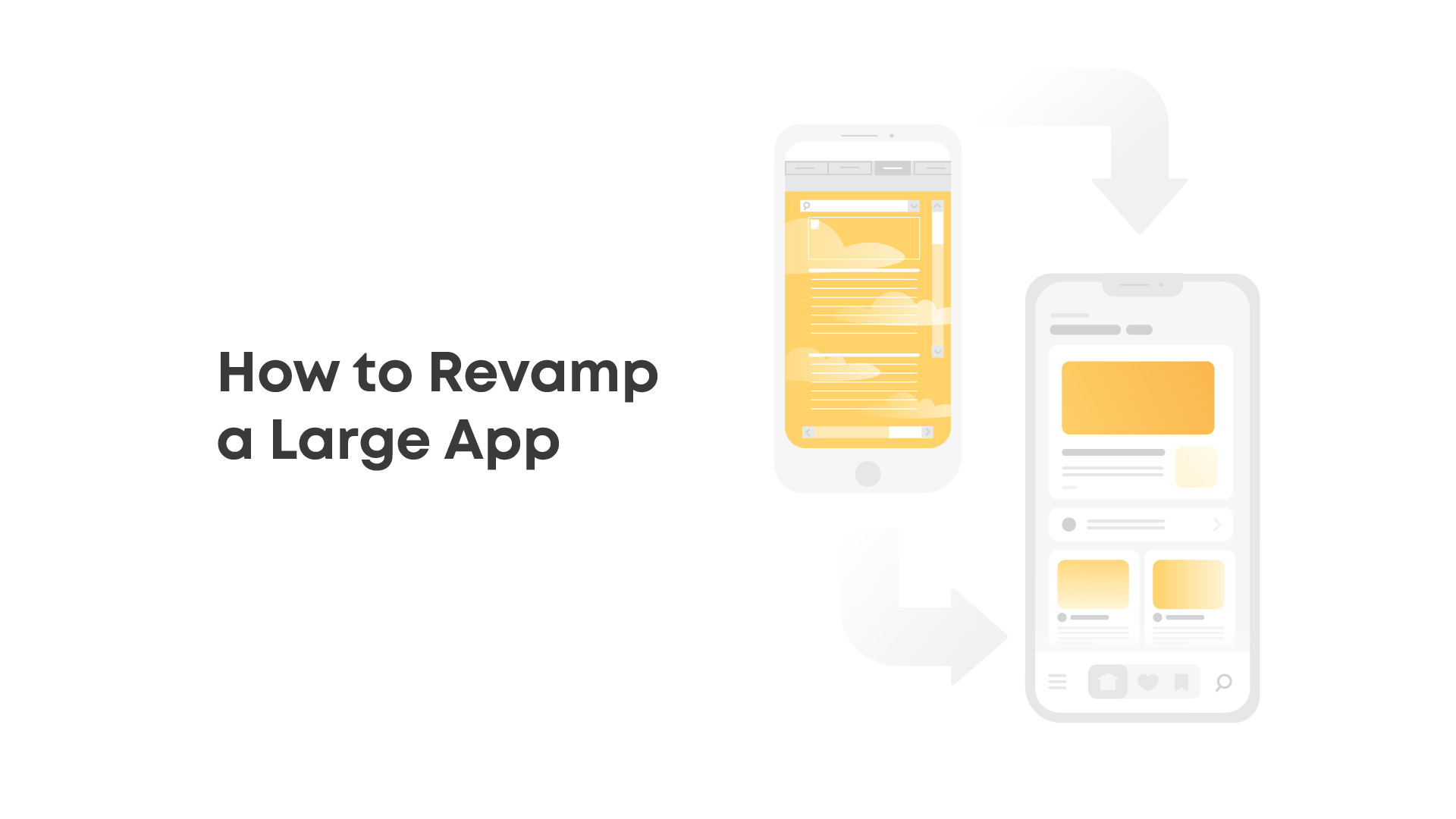Are you looking to improve your application’s performance or user experience? Well, you might want to consider a complete application rewrite and migration.
Now, you might be thinking, “Why would I need to rewrite my entire application? That sounds like a lot of work.” And you’re right — it’s an awful lot of work. But sometimes, it’s necessary.
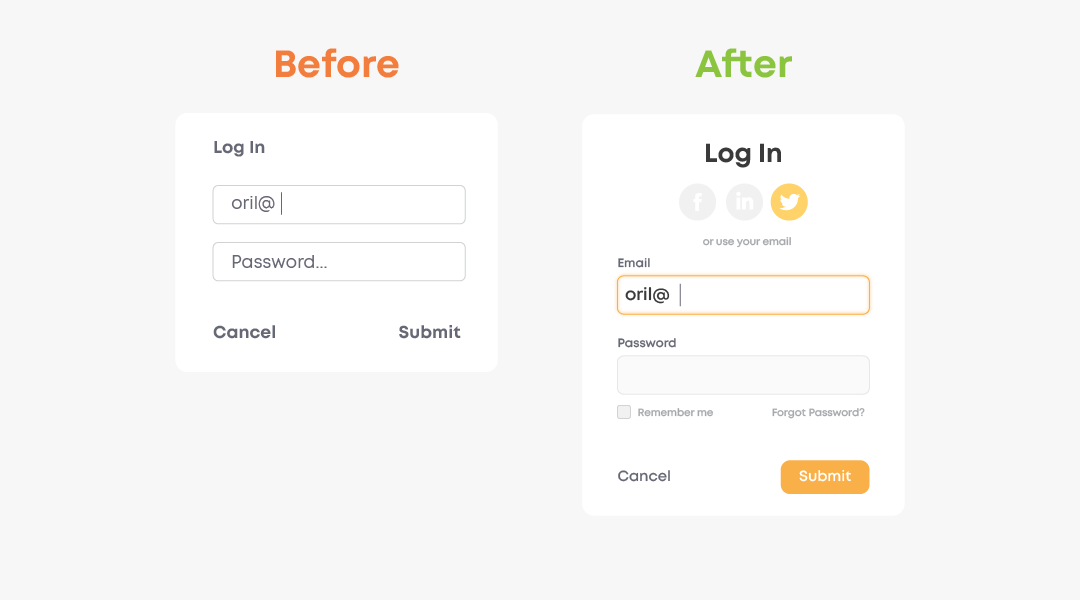
Technology is constantly evolving, and so are user habits and preferences. So, if you’re looking to future-proof your application and stay ahead of the game, a complete application upgrade might be the best approach. But how exactly do you go about doing this?
At ORIL, software renovation is a fairly common request. We’ve been there multiple times, so we know what steps to take and what to avoid to get positive outcomes with less stress. In this article, we share insights we have accumulated during years of work. Here are actions we believe to be essential for a successful app revamping.
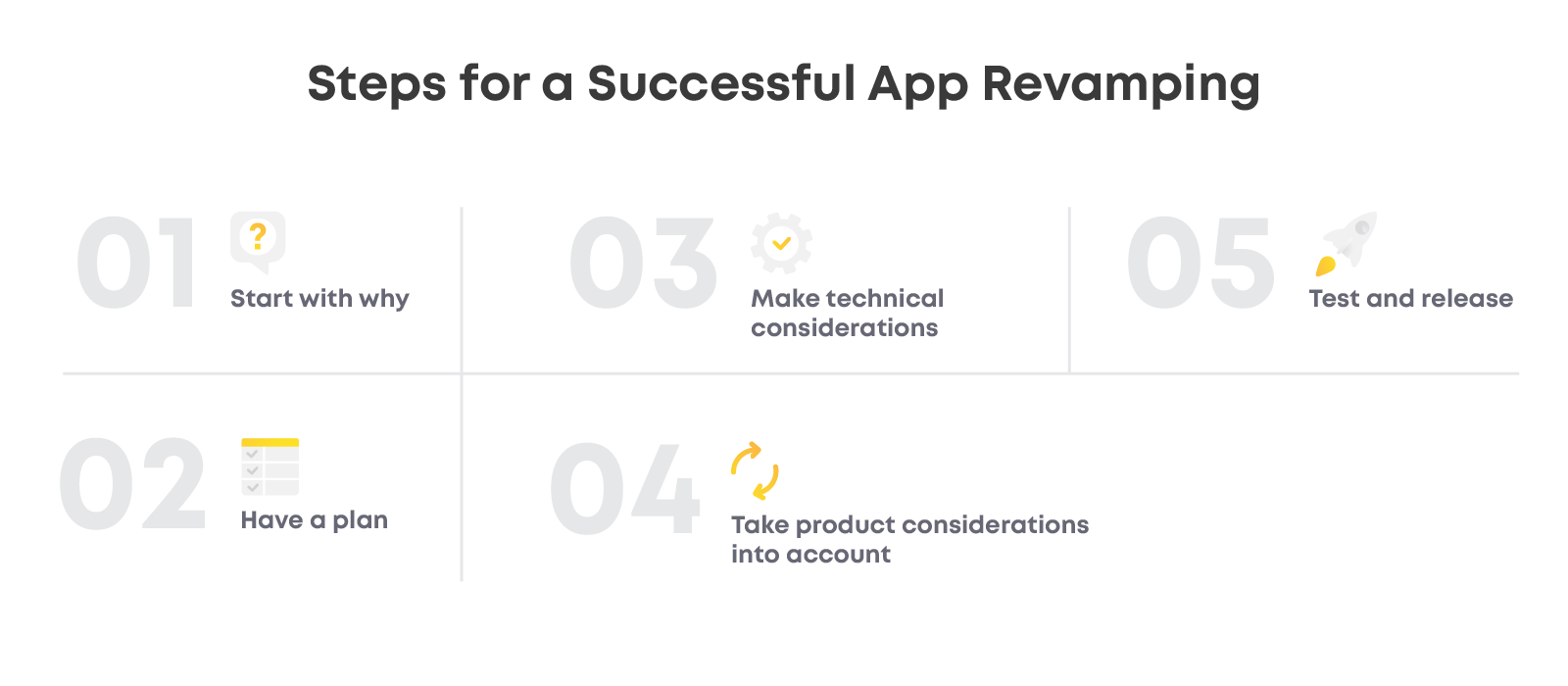
1. Start with Why
What stands behind your desire to refactor the app? Is it an intuitive urge or a data-driven decision? Before you venture into transforming your software, you’ve got to make sure all the efforts are relevant to your business and will yield results.
So, take a step back and really think about your goals and what you want to achieve with the new software version. Consider the pain points in the current app, analyze user feedback, and conduct research on industry trends and best practices. So you know what to work on and whether it is critical for your business.
| Rushing into a revamp without a clear vision of what you want to accomplish can result in wasted time and resources, as well as a less-than-optimal outcome. |
Perhaps, during the course of your decision-making, you will drive to the conclusion that it’s not the right time to invest in complete app rewriting. And that’s ok. So, you may end up implementing minor fixes and design improvements. This step may bring your company more value than inactivity, especially if your resources are scarce. Because full software redevelopment is so much more than rewriting the code or updating the UI (but more on this later), your organization may not be ready to embrace these costly changes.
The Pros and Cons of Application Redevelopment
While it may be tempting to jump right into a software revamp, we strongly recommend you avoid making any rush decisions. Weigh all the benefits and risks your company may encounter. Here are a few things for your consideration.
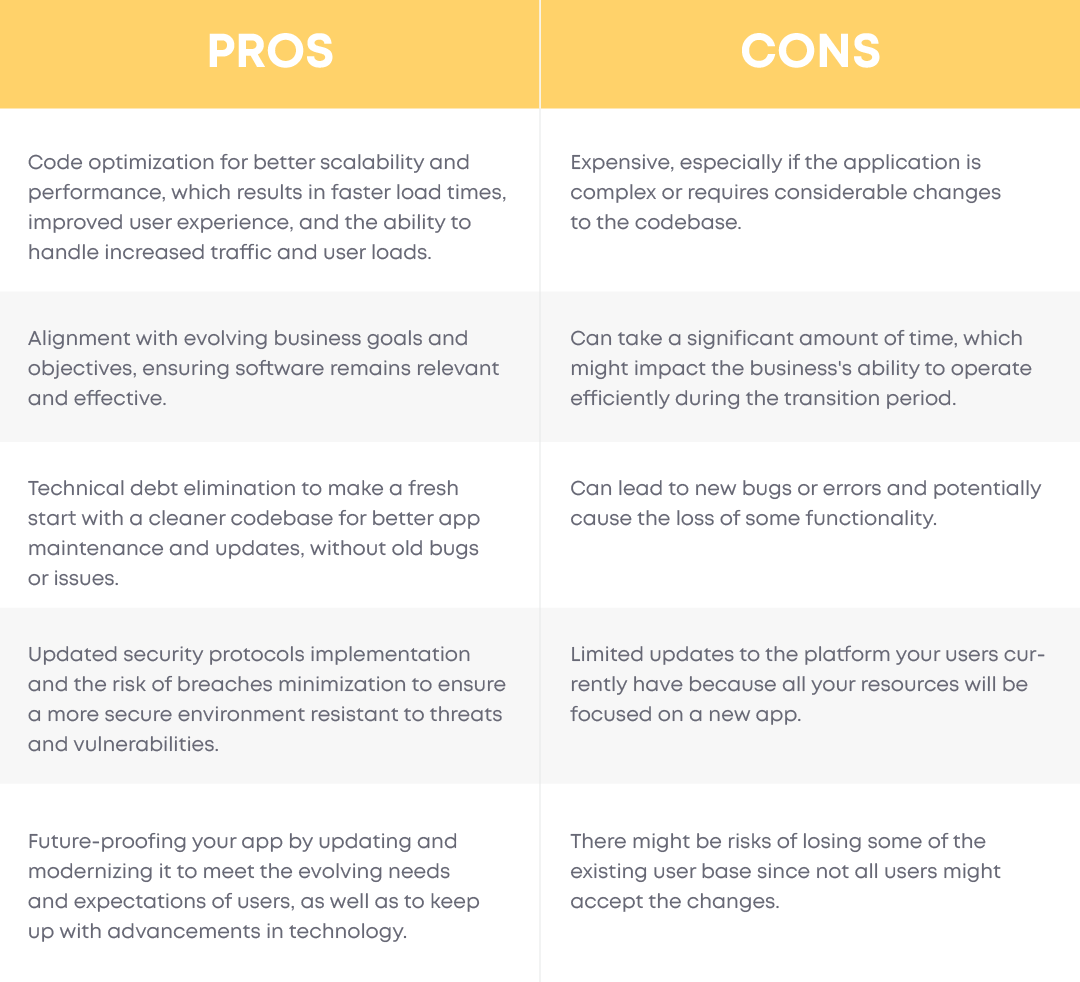
2. Have a Plan
At this stage, you should evoke all the skills of a master strategist and work out a solid plan of action. If you want to do away with missed deadlines, budget overruns, and subpar outcomes, never skip this step. The ORIL team recommends you bear these things in mind to successfully plan app transformation:
- Research during the discovery phase. Planning such a complex and business-critical process as app revamping without proper research is like playing darts with closed eyes. You can trust your gut and keep throwing darts at the dartboard, but what are the odds you will target the bullseye? Invest in the research to accumulate quality data that will help you pinpoint what changes you need to make to meet your business and user needs. Engage all your resources (talk to users, conduct internal interviews, study KPIs, and more) to be able to make decisions based on data.
- Be agile but never compromise planning. When you decide to refactor your app, the stakes are already too high. You are putting at risk a lot of stuff, so make sure everything you do will bring the desired outcomes. For this, stay flexible during the planning stage and be open to new ideas, but do not treat planning as something optional.
- Be open to new UX flows. Even if you believe your old UX flows were perfect, do your best to make them even better. Think outside the box and work on delivering experiences that will impress your users. How? Find hints in our article about the UX design process. The app modernization is going to be a huge change for them anyway. So why not build everything from the ground up avoiding old mistakes?
- Focus on the MVP first. We know that your old app was complex and packed with a variety of amazing features your users loved. But it’s better to narrow down the scope and migrate only crucial features in the first turn. No worries—you will add all the great features over time (perhaps, even more). By taking an MVP approach, you follow the rule of thumb that says less functionality means fewer risks.
- Allocate the budget wisely. Careful budgeting is about ensuring you have enough resources to complete the project successfully. Consider all the costs associated with the project like development time, testing, infrastructure, and any necessary integrations.

3. Make Technical Considerations
First and foremost, app reengineering has plenty of technical considerations. The decisions you make about the tech stack can greatly impact the user experience, app performance, and overall success of the project. So, what tech aspects should be on your agenda?
Infrastructure
App infrastructure refers to the underlying technology that powers your app, such as servers, databases, and networks. It’s what enables your app to function properly. So, it is critical for ensuring that your software can handle user traffic, process data, and deliver content efficiently. Here are the things that may concern you in the first turn.
- Cloud migration. Are you still hosting your own servers? Perhaps, the time has come to consider migrating to the cloud. Cloud migration will help you achieve scalability and flexibility, improved cost-effectiveness, and enhanced security and reliability. It may also enable easier deployment, management, and maintenance of a new application, making it a preferred option for your business. Consider vendors like AWS, Azure, Google Cloud, IBM Cloud, Oracle Cloud, etc..
- Environment alignment. When software development and testing environments are identical to the production environment, you ensure that the app functions properly, minimizing the risk of errors or other issues that can impact the user experience. Also, you may want to consider adding an environment that will replicate the production environment if you’ve got to migrate a lot of users.
Security
Saving money on security is a bad idea, a very bad idea. For instance, the average cost of a data breach in the USA is estimated at 9.44 million U.S. dollars. For many businesses, this amount can be devastating.
Just like any technology, hacking techniques evolve, too. So, cyber attacks are becoming increasingly sophisticated and complex. Hackers do their best to find new vulnerabilities in software and gain unauthorized access to systems and data. That’s why taking proper care of the app’s security is more important than ever.
So, as you take steps to revamp an app, take strong security measures and use the latest security patches and updates.
Application Architecture
What’s the best approach to building your app—monolithic, microservers, serverless, or event-driven? That’s a big question that doesn’t have a canned answer. But after a thorough analysis of your future app’s goal and functionality, you or the development team will quickly grasp which architecture will meet your needs better.
Additionally, containerization and CI/CD are popular approaches that enable speed up and automate app development and deployment.
- Application Containerization is a process of packaging software applications and their dependencies into “containers”, which can be easily moved between different computing environments. These containers provide a consistent and portable environment for the software to run in, which can help simplify development and deployment.
- CI/CD, or Continuous Integration and Continuous Delivery, is a set of practices and tools that help automate the process of building, testing, and deploying software. With CI/CD, developers can automatically build and test their code as changes are made, and then deploy it to production environments with minimal manual intervention.
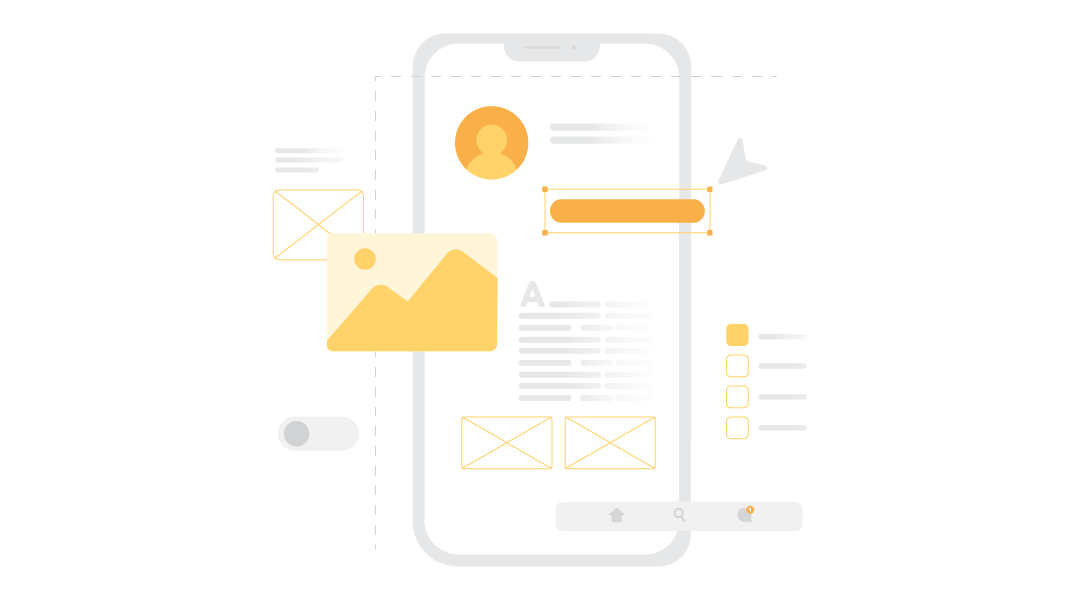
APIs and 3rd Party Services
A full product revamp is a big step. So why not unload your app from unnecessary complexity by integrating 3rd party services to add desired functionality in a snap? This way, you do not have to invest time and energy in building those features from scratch. You just delegate functionality to expert services, and here you go. For instance, MailChimp for email marketing, Twilio for communication, DocuSign for document signatures, and Auth0 for authentication and authorization.
These solutions have a few significant benefits:
- save time and resources during the development process—add functionality quickly and easily;
- improve the user experience — access a wide range of features and services that would be difficult or costly to build from scratch;
- enhance the overall reliability and security of the app—reduce the risk of errors and vulnerabilities that could impact the app and its users by relying on trusted, well-established integrations;
- minimize maintenance efforts — the vendor will be in charge of fixing bugs, releasing new features, etc.
Global Refactoring
You may be tempted to reuse some of the code snippets in your new app. After all, they worked pretty well and never failed.
But that was in an old environment, with an old code. When you bring the old code to a new environment, it may not work properly. Also, there is always the risk of carrying bugs or errors from the old software to a new one, which we want to avoid.
Also, if you would like to get faster load times, smoother performance, better overall user experience, and greater scalability, forget about the old code — rewrite it completely.
There will be no way for innovation either. Using an old code is similar to what Henry Ford once said during the development of the Ford Model T — it hinders the adoption of new technologies. Dismount from your horse! Saddle up the technology of the future.
| “If I had asked people what they wanted, they would have said faster horses.” Henry Ford |
Speed & Performance
Is your existing app lagging? You can improve the overall performance by refactoring the code. Yet, there are other specific performance improvement activities that may take place to enhance the software’s operational speed, here are some of them:
- In high-intensity applications, you want your app to respond quickly to user requests and work fast and smoothly. So, you may want to consider using an in-memory data grid to store frequently requested data in the grid, which is located close to the server. This way, you can reduce read-write latency. Hazelcast is the most suitable option for this purpose.
- Websockets are bidirectional protocols that allow your app to engage users in real-time. They send new data to the user whenever something happens without the need for page refreshes or pull requests, making the app feel alive.
- When users load an application, they may experience slow performance or even lost requests. That’s not good for the user’s end. These issues can even prevent users from using the app. Adding server scaling capabilities can help solve the issues. Scaling up during peak hours ensures the application works smoothly for all users, while automatically scaling down during low usage periods reduces costs.
- The process of read/write data to the database is one of the most time-consuming operations in an app. So, to improve its performance, consider optimizing data, database queries, or even implementing data caching. These actions can drastically increase app performance.
Data Structure & Migration
When you fully rewrite/refactor an app, it’s likely that the database entities will be also changed during the process. This may lead to errors and bugs as this will break the code that relies on them.
To avoid any disruptions to the app functionality, you’ve got to think about how a new app will be working with outdated data. Usually, you’ve got to create new modified database entities from your old data. This process is usually called a database migration.
When your new data structure is ready, you would need to create a separate environment to check how new data works with new software. This will help spot bugs or test workflows as well. If things run smoothly, you will have to repeat running this data transformation. But this time, on real data and in the production environment.
4. Take Product Considerations Into Account
In addition to technical considerations, there are plenty of product-related things you’ve got to keep in mind when revamping an app.
- Analytics. Set up analytics from the very first days of the new app release. This will help you understand whether you are moving in the right direction and what actions you should take to improve your app in the future.
- Supportive apps. Update all supportive apps like the Admin panel to sync them with new flows. This will help decrease manual work and unlock a new level of employee productivity.
- User support. A new app is going to be a huge change for the users. Some will accept it, others will need time to get accustomed to it. But you can minimize the number of disoriented users by providing proper tutorials. Of course, you won’t make every single app user happy with a new update. Just make sure that the majority of your audience is happy with the new interface and functionality.
- Customer service. Customer care agents are probably the first people in your company who would encounter floods of user feedback, both positive and negative. Collect it to further analyze everything your users say and make educated decisions in the future. Your support team will also get tons of requests asking for help or issue troubleshooting. Train your staff and make sure they are well aware of how to help users navigate a new app.
- Legal. Handle all legal aspects associated with a product revamping. Update your Terms of Use, Privacy Policy, and other papers and web pages. Also, make sure a new app complies with all applicable laws and regulations, including data protection and privacy laws such as GDPR and CCPA.
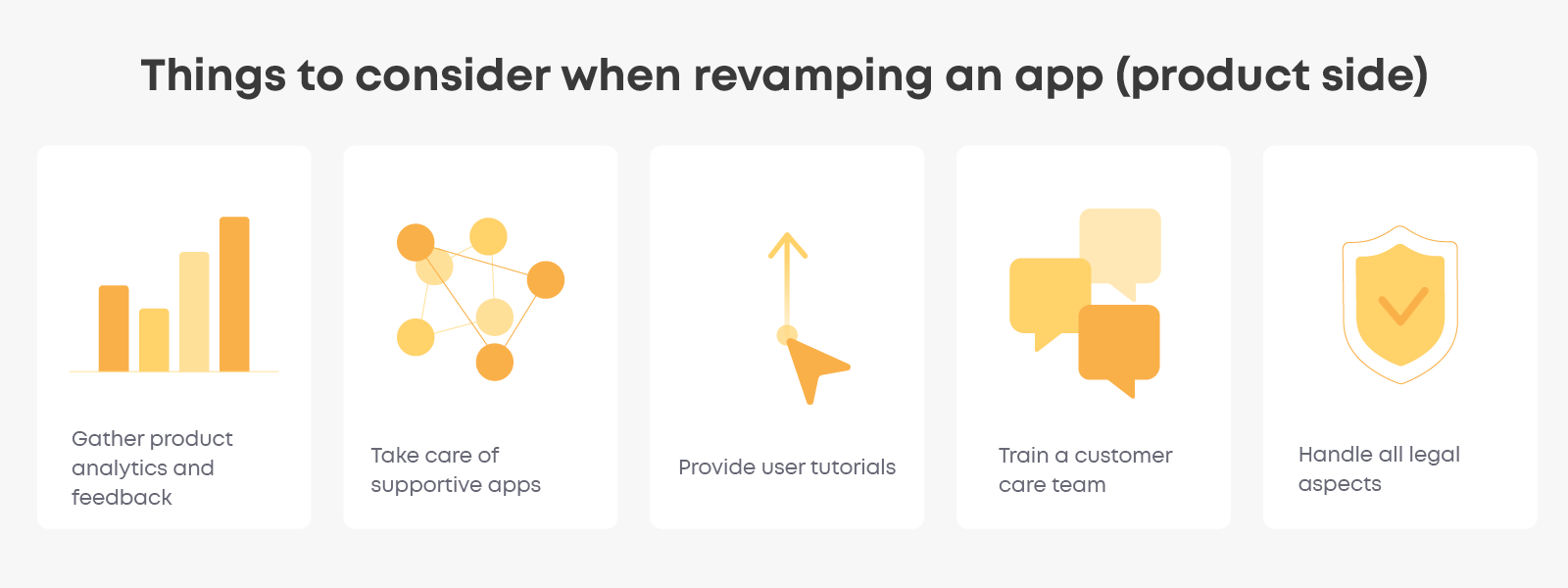
5. Test & Release
Let’s face it — nobody likes a buggy app! Users can quickly lose patience when things don’t work the way they’re used to. We bet you don’t want to release a new version of an app that crashes on launch or has features that just don’t work. Testing allows you to catch those bugs before they wreak havoc on your users’ experience. This is also an essential step to make sure your new app is in line with the goals defined at the outset of the project. Discover more perks in the article on benefits from having a QA engineer on your team.
- We strongly recommend running load and stress tests. That’s what will ensure an app runs smoothly, even in conditions of heavy traffic and stress conditions.
- Write the tests during the development of the software like unit, integrations, and mocking tests to avoid fixing costly bugs and errors after production.
Conclusion
Revamping your application is like getting a fresh haircut — it’s necessary for your app to stay on-trend and relevant. As you take the plunge, your app will take advantage of new technologies, improve performance, enhance security, and provide a better user experience.
With the right planning, technical and product considerations, and testing, you can achieve a high-performing app that’s secure, efficient, and user-friendly. While this process may seem daunting, you don’t have to be alone on your route to a better app. As a seasoned app development company, we will get the best experts to work on your software revamping to reduce the risks and deliver a solution catered to your needs.
Don’t let your app fall behind. Let’s transform, and may your new software attract more users and boost your business.
